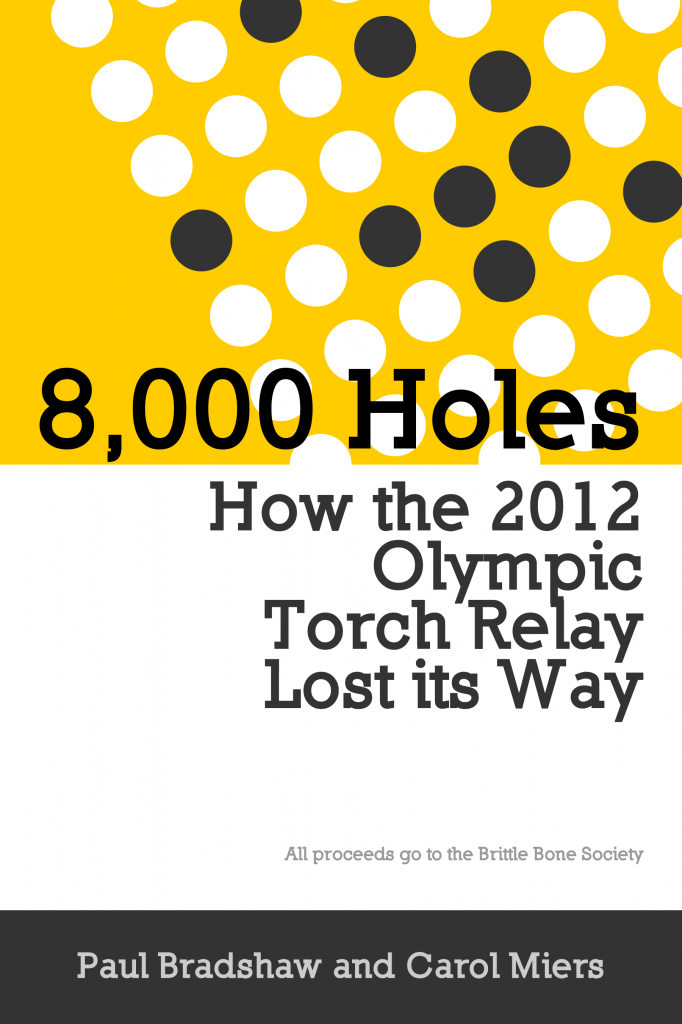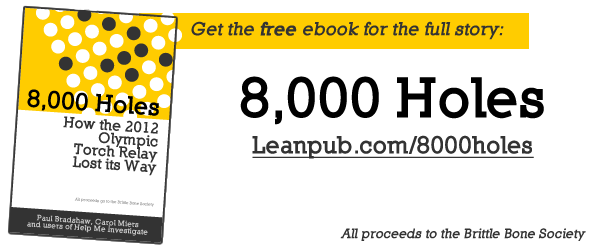Our ebook 8,000 Holes: How the 2012 Olympic Torch Relay Lost its Way has now been published in the Kindle store. All proceeds go to the Brittle Bone Society. Tell your friends – or gift it!
Tag Archives: 8000 Holes
The experience of the torchbearer – and the executives who carried the Olympic torch on just one day – 8,000 Holes part 5
Part 5: 8,000 Holes
In June 2011, when the design for the official Olympic torch was unveiled, the Chair of LOCOG Sebastian Coe had said:
“The Torch that carries the Olympic Flame during the Olympic Torch Relay is one of the most recognisable and significant symbols of an Olympic Games. Members of the public right across the UK are busy nominating inspiring people to be Torchbearers and I am thrilled we have a beautifully designed, engineered and crafted Torch for them to carry.
“Integral to the design are the 8,000 circles, a lasting representation of the Torchbearer stories of personal achievement or contribution to their local community that will be showcased with every step of the Relay.”
But too many of those 8,000 circles turned out to be merely holes where local heroes should have been. The “message of inclusion” which the torch was supposed to represent had been replaced with a repeated message of exclusion. At almost every point where places were split up, a proportion was siphoned for allocation through non-public processes, whether the 15% of Lloyds TSB places for staff; the 10% of Samsung’s places; Coca Cola’s nomination judges carrying the torch as Future Flames, or the corporate partners who rewarded board members and business partners. Continue reading
The 21% of torchbearer places that were allocated outside of public campaigns: 8,000 Holes Part 4
In the fourth part of a serialisation of Help Me Investigate’s first ebook – 8,000 Holes: How the 2012 Olympic Torch Relay Lost its Way we look at what happened to the thousands of torchbearer places that were allocated outside of public campaigns. You can download the book for free – or choose to pay a donation, with all proceeds going to the Brittle Bone Society – at Leanpub.com/8000holes
Part 4: The 21%
Between December 2011 and June 2012 the numbers of torchbearer places being awarded by bodies other than the Presenting Partners and LOCOG increased by a third. The International Olympic Committee‘s share of places saw the biggest change, going up by half – from 71 according to a December press release to 117 six months later, while commercial partners other than the three presenting partners – dozens of companies including Dow Chemical, G4S, Atos and BT – saw their share go up from 678 places to 913. Continue reading
A very specific “general” public? How the 2012 Olympic Torch Relay lost its way part 3
In the third part of a serialisation of Help Me Investigate’s first ebook – 8,000 Holes: How the 2012 Olympic Torch Relay Lost its Way we look at the claim that 90% of torchbearer places would be available to the general public. You can download the book for free – or choose to pay a donation, with all proceeds going to the Brittle Bone Society – at Leanpub.com/8000holes
Part 3: A very specific “general” public
Although news reports at the time said that 90% of all torch relay places would be “available to the general public”, a careful reading of LOCOG’s language and figures suggests that this was not entirely accurate. The chief executive of LOCOG was careful to say that places “were made available to the public through a number of channels, including the four public nomination campaigns run by Locog, Coke, Lloyds TSB and Samsung.”
With fewer than three quarters of places available through those four public nomination campaigns, the remainder would be allocated through other channels which restricted their availability to the ‘general’ public to varying degrees. Continue reading
How the 2012 Olympic Torch Relay lost its way part 2: The presenting partners
In the second part of a serialisation of Help Me Investigate’s first ebook – 8,000 Holes: How the 2012 Olympic Torch Relay Lost its Way we look at how the presenting partners’ allocation of torchbearer places was handled. You can download the book for free – or choose to pay a donation, with all proceeds going to the Brittle Bone Society – at Leanpub.com/8000holes
Part 2: Getting your money’s worth
Once the Presenting Partners were able to start awarding torchbearer places, each handled their allocation differently.
As the only national presenting partner, Lloyds TSB allocated their places through two UK-wide campaigns: one through Lloyds TSB itself, and another through Bank of Scotland. The bank said they would give the opportunity to “people who have made a difference in their community”.
An analysis of the data on both banks’ official torchbearer sites, however, finds almost 500 of their 1,360 places unaccounted for, and when pressed, the bank admits that: Continue reading
Help Me Investigate interviews Jack Binstead for The Guardian’s Writers Relay
Carol Miers’s interview with wheelchair racer Jack Binstead is published today in The Guardian.
Today is the day that Jack was most likely to have carried the torch, had his nomination by 20 people been successful.
Instead he and his family are flying out of the country. Continue reading
How the 2012 Olympic Torch Relay lost its way part 1: Jack Binstead’s story
This is the first part of a serialisation of Help Me Investigate’s first ebook – 8,000 Holes: How the 2012 Olympic Torch Relay Lost its Way. You can download the book for free – or choose to pay a donation, with all proceeds going to the Brittle Bone Society – at Leanpub.com/8000holes
Part 1: Where did the torchbearer places go?
Jack Binstead is one of the UK’s most promising young athletes: a wheelchair racer in with a chance of competing in the next Paralympic Games. Born with brittle bone disease he has, says his mother Penny, broken 64 bones in his body over just 15 years.
“At the age of nine he was a very down young boy,” she explains. “He was very overweight – he didn’t know which way to go. But when he went to a taster session for children with special needs, the borough’s Head of Sports saw in Jack that he would be good at wheelchair racing. He recommended that Jack try wheelchair racing at a local track in Kingston called Kingsmeadow.”
New details in ebook from HMIO: How the 2012 Olympic Torch Relay Lost its Way
As the Olympic Torch Relay enters its final week we are today publishing Help Me Investigate’s first ebook: 8,000 Holes: How the 2012 Olympic Torch Relay Lost its Way.
A longform report, the book details how the 8,000 torchbearer places were allocated – and how that process made it impossible for Olympic torch relay organisers LOCOG to meet key promises about the numbers of places available to the public, and to young people.


